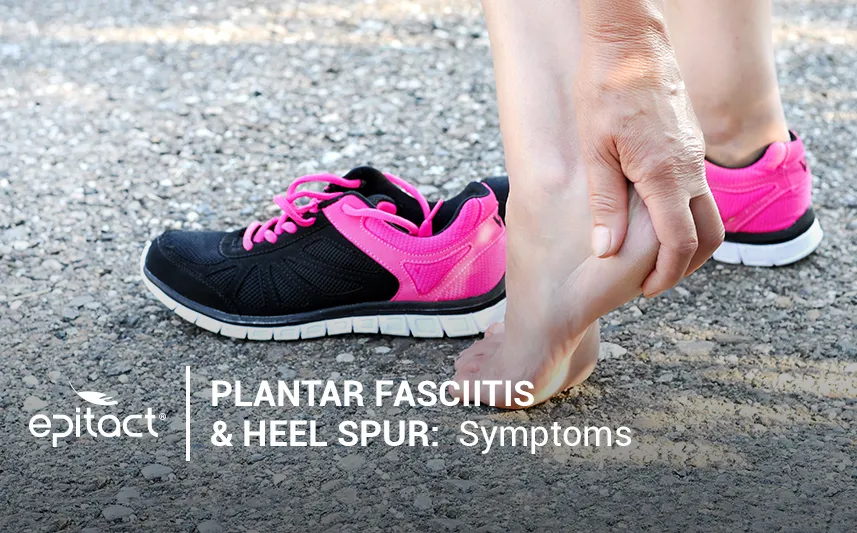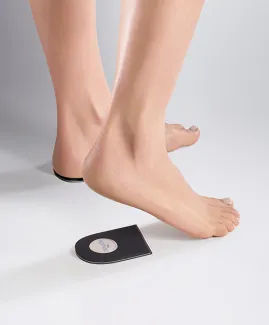
The symptoms of plantar fasciitis are the consequence of the inflammation of the fibrous band of tissue that connects your heel to your toes.
It is often related to heel spurs because both conditions occur at the same area and have the same causes and symptoms. Indeed, a heel spur would be present in 80% of patients with plantar fasciitis(1). Having a heel spur is commonly benign and painless, and its presence is only revealed by X-Ray.
What does a heel spur feel like? How to describe heel pain from plantar fasciitis? With EPITACT®, discover the symptoms of a heel spur and plantar fasciitis, as well as their solutions to relieve pain!
Symptoms of a heel spur
A heel spur, bony outgrowth of the heel bone, is generally painless. Most of the time, heel pain is the result of the plantar fascia inflammation, where it attaches to the calcaneus. This inflammation can lead to the formation of a heel spur. In the end, the bony outgrowth is not the cause but the consequence of plantar fasciitis.
Sometimes, the spur even remains after the inflammation has been treated. Also, it seems that the length of the spur (commonly a few millimetres long) has no relation with the intensity of pain.
However, a heel spur can lead to other symptoms like plantar fat pad atrophy. In this case, heel pain occurs where the spur forms and accentuates the already existing pain. This can have serious consequences on walking and mobility(2).

The main symptom of plantar fasciitis is heel pain
You wonder What does plantar fasciitis feel like? Inflammation of the plantar fascia appears to be the main cause of heel pain. Pain is one of the only, if not the only symptom of plantar fasciitis.
Heel pain from , as a symptom of plantar fasciitis, can be described in many ways.
The location of heel pain from plantar fasciitis
Pain can appear in two different areas of the sole. This symptom of heel spurs and plantar fasciitis Pain can affect the whole fascia or the heel (where the fascia attaches to the calcaneus). Therefore, it can be diffuse and radiate the sole of the foot or be localised under the heel.
The intensity of plantar fasciitis symptoms
People suffering from plantar fasciitis describe acute stabbing heel pain. They compare it with a burning sensation or a sensation of a nail being driven into the heel.
The frequency of pain
The painful symptom of plantar fasciitis usually occurs when the foot is supporting the body weight. It can be during prolonged standing positions, the morning while standing or after sitting for long periods of time. It also appears after a long work day or after some sports activities or when the foot hits the ground forcefully.
What are the relieving and risk factors of the symptoms of plantar fasciitis?
As we’ve said, heel pain mostly appears when the heel supports the body weight (walking, running). A deviation of the foot or tight calf muscles are other aggravating factors of plantar fasciitis. On the contrary, heel pain from plantar fasciitis decreases during motion or when the body weight does not press the inflamed area (rest, sitting position, etc.).
What solutions exist to relieve heel spur and plantar fasciitis symptoms?
To relieve the symptoms of a heel spur and plantar fasciitis, you can adopt the following solutions:
- rest: when the plantar fascia isn’t under stress anymore, inflammation reduces and so pain.
- insoles or heel lifts decrease heel pain from plantar fasciitis and heel spurs. By slightly lifting the heel, the EPITACT® heel lifts* efficiently and comfortably reduce the tension on the plantar fascia. The thickness of the silicone pad provides comfort to the painful area. Then, the material used for the heel lift absorbs shocks every time the foot hits the ground. Designed to be ultra-thin and discreet in the shoe, they bring additional comfort while walking! Lastly, they’re adhesive, thereby perfectly holding in the shoes. They also contribute to decreasing joint and back pain.
- stretching exercises aim to stretch the foot tissues like the plantar fascia. They limit excessive tension on it and then reduce inflammation. The article by EPITACT® provides you all the information to do those stretching exercises properly and relieve the symptoms of plantar fasciitis.
- if you are overweight, try to lose weight in order to reduce the stress and pressure on the bottom of your foot.
- comfortable and supportive shoes can also help relieve plantar fasciitis symptoms. They should have a cushioning sole and provide good support for the arch of the foot. You can choose shoes with a small height of heel (around 3 cm) or add heel lifts inside.
The most common in heel spurs and plantar fasciitis symptoms is intense heel pain. Click HERE to find out other ways to prevent heel pain from plantar fasciitis and learn more about the treatments of heel spurs and plantar fasciitis.
*This solution is a class I medical device that bears the CE marking under this regulation. Carefully read the instructions before use. Manufacturer: Millet Innovation. 01/2022
For more details about this general and simplified approach, here are further sources:
(1)Kuyucu E, Koçyiğit F, Erdil M. The association of calcaneal spur length and clinical and functional parameters in plantar fasciitis. International Journal of Surgery. 1 sept 2015;21:28 31.
(2)Mücke R, Schönekaes K, Micke O, Seegenschmiedt MH, Berning D, Heyder R. Low-Dose Radiotherapy for Painful Heel Spur: Retrospective Study of 117 Patients. Strahlenther Onkol. nov 2003;179(11):774 8.
 Pharmacie
Pharmacie